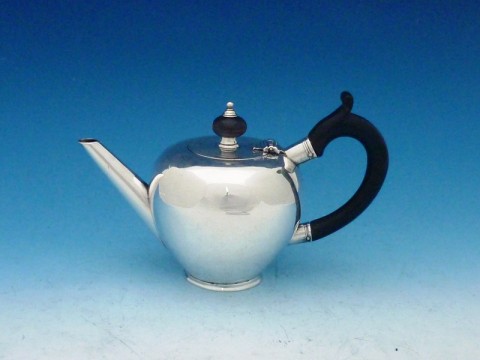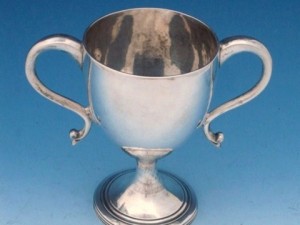
The Republic of Ireland is in desperate need of a philanthropic angel to preserve an immensely important part of its history and cultural heritage.
The National Museum of Ireland currently has on exhibit a phenomenal collection of 107 choice pieces of Irish silver spanning the history of sterling craftsmanship on the Emerald Isle. On temporary loan from a private collection in Dublin, the exhibit details the evolution of style in silver wares from the dawn of the craft in the early 17th Century, to the Baroque and Rococo schools of the early 18th Century, through the Georgian period of the 18th to early 19th Centuries, to the Classical and Neo-Classical movements of the Regency, and Revival Periods of the 19th Century. The collection documents the work of Ireland’s most important silversmiths, and illustrates the many uses of silver in their historic social and economic contexts.

With the benefit of this collection, the Museum of Decorative Arts at the Collins Barracks in Dublin curates the premier collection of Irish Silver in the world, surpassing even that of the venerable Victoria and Albert Museum in London. As it should. But unfortunately, not for much longer.
The loan of this seminal private collection expires at the end of February, at which point it will be broken up and sold. The dispersal of this magnificent assembly will be a terrible loss for the Republic of Ireland, for the preservation and recognition of Irish culture, and for antique silver scholars, curators and collectors. This is a rare and wonderful opportunity for a philanthropist (or consortium of generous Irish Americans) to step forward and purchase the collection intact, and donate it to the National Museum. The lot is valued at approximately $2.4m, and can be viewed on the website of the Dublin and London silver dealers L and W Duvallier at antiqueirishsilver.com. What an amazing act of benevolence… and what an amazing tax deduction!

Antique Irish silver is among the finest in history, at the pinnacle of the silversmith’s art. Irish decorative arts benefited tremendously from the prevailing state of an exceptionally wealthy landed aristocracy, occupying a land with a fortuitously talented (and often very well educated) but impoverished population, thus yielding demand and wherewithal on the one hand, and ability and low wages on the other. Irish craftsmanship in the 18th and 19th Centuries was superb and arguably unsurpassed, as we see in the carved Chippendale furniture and the brilliant glassware and crystal of the period. Silversmiths were fewer in Dublin than in England or America, so their output was much smaller, and consequently today is much rarer and more valuable. The Irish provincial work from Cork, Galway, Limerick or Kinsale is much rarer still, and consequently even more dear.

Identifiable Irish silver dates back to the royal charter of the Company of Goldsmiths of Dublin in 1637. The earliest Irish silver was plain but well-fashioned, characterized by heavy gauge and relatively simple forms. Silver was originally used mostly in church wares (such as chalices, communion cups and plates, etc.), and did not appear in domestic household use until the end of the 17th Century when we begin to see candle sticks and two-handled cups. Huguenot silversmiths fleeing France after 1685 brought new ideas and refinement, preparing Irish silver to flourish in the approaching age of elegance.

Irish silversmiths embraced, even led, the exuberant aesthetic of the mid-18th Century Rococo style. New lifestyles demanded new accoutrements, and domestic silver soon included tea and coffee pots, jugs, spoons and serving utensils, salvers, caddies, tureens, tankards and mugs. As the century passed and empires churned, they became masters of the refined Neo-Classical movement, before coming into their own with the socio-politically important Celtic Revival.

Irish silver developed outside of the close control of the English guilds, and so explored more freedom in their designs. Their spirit of independence seems to align them closer to American artists in style, than their British contemporaries. Their work is grander, ornate yet symmetrical, bold yet gracious. A connoisseur can, in fact, discern Irish from English silver from its style and design, before examining the hallmarks. Their work attained a quality and elegance which has never been surpassed. Their legacy remains a high point in the realm of antiques.
_________________________________________________________________________
All silver items illustrated are part of the collection on exhibit at The National Museum of Ireland, and can be viewed on the website of the Dublin and London silver dealers L and W Duvallier at antiqueirishsilver.com.
_________________________________________________________________________
If you enjoyed reading this blog and all things antique, please visit our shop at 14 Easy Street on Nantucket Island (508-228-1287) and our website http://www.nantucketantiquesdepot.com/ ____________________________________________________________
Visit www.nantucketchronicle.com/ , your free online resource for everything Nantucket. By Nantucketers, for Nantucketers.
________________________________________________________________________
Please excuse any annoying advertisements that may appear below this. The intrusion is on the part of the hosting site, and is in no way endorsed by the Antiques Depot.
_________________________________________________________________________
